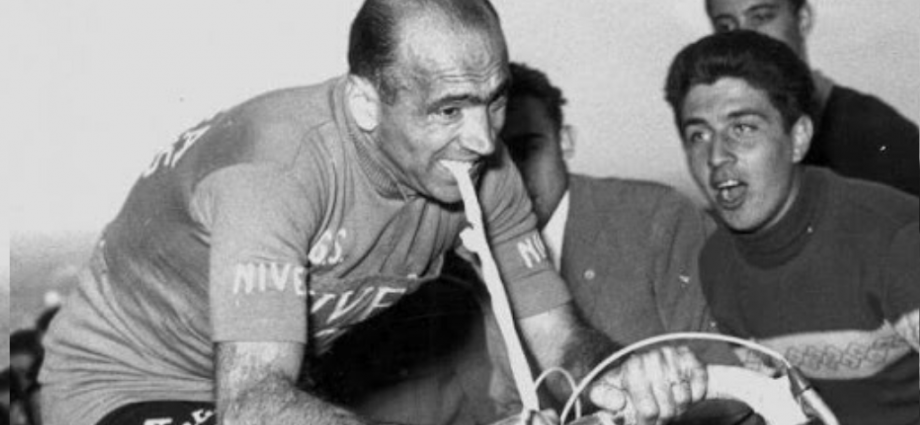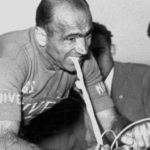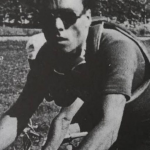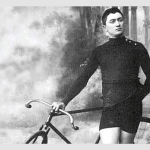You might have always wondered what is that strange picture of Fiorenzo Magni holding something between his teeth with an heroic effort displayed on his face. As most of the legendary cycling images, this one has its extraordinary backstory too.
According to the pre-race predictions, Giro d'Italia 1956 was dubbed as the fight between the old and new generation. Fausto Coppi was no more the same he used to be, the scandal emerged in his private life recently had a serious impact on his racing performance, and he crashed out on the 6th stage.
Please, support PelotonTales
Another old giant in the peloton was the three-time Giro-winner Fiorenzo Magni. But despite some unlucky situations, he refused to leave the race.
Even after he broke his collarbone.
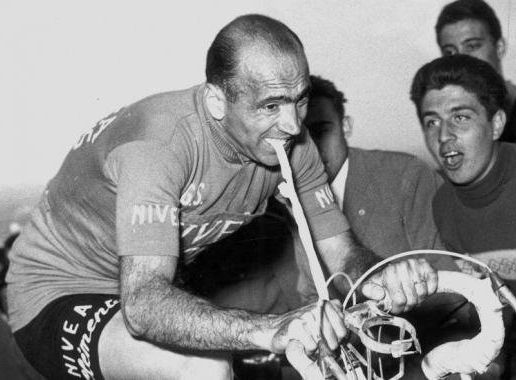
"Lion of Flanders"
Fiorenzo Magni, the "Lion of Flanders" was always a hard man, was fighting during the WW,2 even after the Armistice in 1943 - on Mussolini's side. After the war, he was charged with taking part in a massacre where a partisan leader was killed among others. Magni was acquitted, but this story still had an impact on his career in some ways. For example, his unpopularity among the tifosi made him race rather in Belgium, where he won the Ronde van Vlaanderen three times.
However, he did not gave up to race at home entirely, and was also a three-time Giro d'Italia winner (1948, 1951 and 1955).
Before the start of the race in 1956, he has announced, that this would be his last Giro. Probably, he never thought this would be one of the most memorable races of his career.
Racing with broken collarbone
On the stage between Grosetto and Livorno (usually called stage 12, but sometimes stage 10) Magni crashed on the descent out of Volterra and broke his left collarbone. However, he still managed to finish the stage. Later in the hospital, he was recommended to quit the race, but he refused it. The next day was a rest day, Magni has only one thing to do: to do nothing at all.
MORE GIRO D’ITALIA STORIES
Fiorenzo Magni and the Giro d’Italia 1956
You might have always wondered what … Read more
The story of the Maglia Nera (Giro d’Italia 1946-1951)
Between 1946 and 1951 a special … Read more
Giovanni Gerbi’s last Giro d’Italia
Giovanni Gerbi (1885-1955) is the oldest … Read more
Although he got an elastic bandage from the doctors, his left arm was still short on power.
His chief-mechanic came with the idea to cut out a piece from an inner tube. Its one end could be attached to the handlebar, while Magni kept the other end with his teeth.
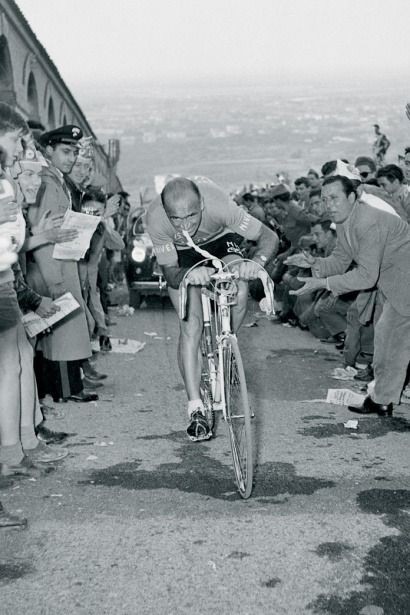
Never give up
On the stage from Lecco to Sodrino, Magni crashed again. He fell on his left arm, broke his humerus, but refused to go to the hospital. He left the ambulance car, pedalled back to the peloton, which was patiently waiting for him.
Although the protagonist of the epic stage up to Monte Bondone was Charly Gaul, Magni had his own part in this extraordinary story too. Not to forget, his collarbone was still broken, his racing abilities quite reduced. He did nothing special, only never gave up the race, although it was so cold, that even the winner Gaul had to be literaly cut out of his frozen jersey after the stage.
Pasquale Fornara led the GC before the stage, but even he gave up the race. Magni remembered it this way:
"They told me, that most of the peloton froze and had to quit. Then, before reaching Trent I saw the Pink Jersey quitting too! 'What?? Am I seeing things?" I wondered. If I were the Pink jersey I would have continued, even if I had to walk, but I would never abandon."1
Indeed, he never gave up, and crossed the finish line third that day. Thanks to his persistent performance, he jumped up to the 2nd place in the general classification. At this point, Charly Gaul was the leader of the race with an advantage of 3 minutes and 27 seconds.
Only 2 stages were left, and Magni even tried to defeat Gaul. But the end the Luxembourgian won the race and Magni finished just behind him with the same time gap as it was after the Bondone-stage.
- Bill McGann and Carol McGann: The Story of the Giro d'Italia: A Year-by-Year History of the Tour of Italy, Volume 1: 1909-1970.McGann Publishing LLC, 2011. [↩]
